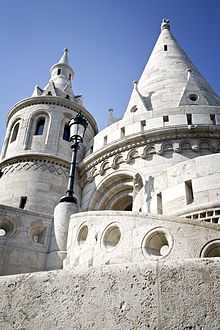Fisherman's Bastion

The Halászbástya Hungarian pronunciation: [ˈhɒlaːsbaːʃcɒ] or Fisherman's Bastion is a terrace in neo-Gothic and neo-Romanesque style situated on the Buda bank of the Danube, on the Castle hill in Budapest, around Matthias Church. It was designed and built between 1895 and 1902 on the plans of Frigyes Schulek. Construction of the bastion destabilised the foundations of the neighbouring 13th century Dominican Church which had to be pulled down.[1] Between 1947–48, the son of Frigyes Schulek, János Schulek, conducted the other restoration project after its near destruction during World War II.
From the towers and the terrace a panoramic view exists of Danube, Margaret Island, Pest to the east and the Gellért Hill.
Its seven towers represent the seven Magyar tribes that settled in the Carpathian Basin in 896.
The Bastion takes its name from the guild of fishermen that was responsible for defending this stretch of the city walls in the Middle Ages. It is a viewing terrace, with many stairs and walking paths.
A bronze statue of Stephen I of Hungary mounted on a horse, erected in 1906, can be seen between the Bastion and the Matthias Church. The pedestal was made by Alajos Stróbl, based on the plans of Frigyes Schulek, in Neo-Romanesque style, with episodes illustrating the King's life.
It was featured as a Pit Stop on the sixth season of American TV show The Amazing Race.

References
External links
| Wikimedia Commons has media related to Fisher Bastion (Budapest). |